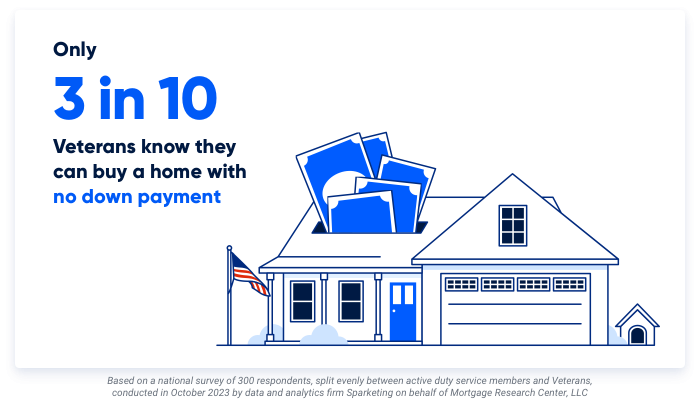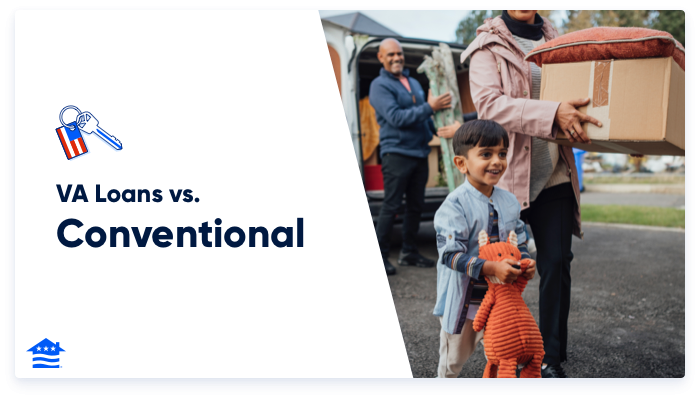Navigating the financial aftermath of bankruptcy can be a difficult journey with limited options. However, VA loans have flexible requirements, offering many Veterans and active duty service members relief after financial hardship.
In this article, we will explore the path to getting a VA loan after bankruptcy, highlighting the waiting periods, type of bankruptcy and steps you can take to rebuild your financial future
How Bankruptcy Affects Your VA Loan Eligibility
There are two major types of personal bankruptcy — Chapter 7 and Chapter 13 — and both can significantly affect your credit. Consumers may see their credit scores drop anywhere from 130 to 240 points following a bankruptcy, depending on the type, the borrower's financial profile and other factors, according to research from credit scoring firm FICO.
The credit score drop alone can make qualifying for a VA loan incredibly difficult, but lenders also require borrowers to be a “satisfactory credit risk,” which is accomplished through a minimum waiting period.
While bankruptcy can undoubtedly impact your creditworthiness and loan accessibility, the good news for VA borrowers is that the credit score hurdle is typically lower than what you'll face for conventional or even FHA loan financing.
VA Bankruptcy Waiting Periods
VA-approved lenders want to see that prospective borrowers can return to a solid financial footing before granting the huge responsibility of a mortgage loan.
The waiting period for a Chapter 7 bankruptcy is typically two years from the discharge date. As for Chapter 13 bankruptcy, you may be eligible for a VA loan once you’re 12 months beyond the filing date
VA Loan Seasoning Periods vs. Other Mortgage Types
Lenders usually have a "seasoning period" for borrowers who have experienced bankruptcy. A seasoning period is how much time you have to wait before being eligible to close on a home loan. Below is how VA loan seasoning periods compare to other common loan seasoning periods:
| Chapter 7 | Chapter 13 | |
| VA Loan | 2 years | 12 months |
| USDA Loan | 3 years | 12 months |
| FHA Loan | 2 years | 12 months |
| Conventional Loan | 4 years | 2 years |
Chapter 7 Bankruptcy
A Chapter 7 bankruptcy is known as a "liquidation" bankruptcy and forces an individual to sell certain assets to repay creditors. Once the assets are sold the remaining debts are discharged from the individual, leaving them with a clean financial slate. The two-year waiting period for VA lenders begins after this discharge date.
Qualifying for VA Loan After Chapter 7 Bankruptcy
To receive a VA loan after Chapter 7 bankruptcy, lenders typically have a few requirements they look for:
- Satisfy the minimum two-year waiting period requirement
- No late payments or new accounts since filing for bankruptcy
- Rebuilt credit score (most lenders look for a FICO score of 620)
- Meet standard VA eligibility requirements
These requirements may vary from lender to lender, so it’s best to speak with a VA home loan expert to understand your specific bankruptcy situation fully.
Chapter 7 Bankruptcy Reaffirmation Agreement
A mortgage is a secured debt, which means it's backed by collateral; in this case your house. Homeowners who go through bankruptcy may want to try and keep their homes through a process known as "reaffirmation."
A reaffirmation of debt after Chapter 7 bankruptcy means you will continue to be legally responsible for your mortgage payment. Talk with an attorney about reaffirmation and its implications for your financial situation before making a final decision.
With a Chapter 7 bankruptcy, homeowners who do not reaffirm will see their legal and financial responsibility for the mortgage end with the discharge. Chapter 7 basically wipes away what you owe on that home. But there's still a lien on the property which gives the lender the ability to foreclose on the property and seek to recoup at least some of their investment. However, it can take months or years for lenders to foreclose. Some prospective borrowers can continue living in the home after the bankruptcy discharge.
Some lenders may require a Verification of Rent (VOR) to verify that borrowers have continued to make timely mortgage payments. Guidelines and policies on this can vary by lender.
Chapter 13 Bankruptcy
Chapter 13 bankruptcy is known as a "reorganization bankruptcy" and creates a court-supervised plan for debt repayment. A bankruptcy attorney works to create a debt repayment plan for the debtor, typically lasting three to five years. Once the debt repayment plan is complete, any remaining debt will be discharged.
A prospective borrower may receive approval for a VA home loan while still making payments on their Chapter 13 bankruptcy if they have made their payments on time for at least one year. They will usually need consent from their Chapter 13 bankruptcy trustee to take on new debt, such as a mortgage.
To reiterate, the seasoning period for VA loan application is based on your Chapter 13 filing date, not the discharge date. That's a big beneficial difference from Chapter 7
If you don’t meet Chapter 7 eligibility requirements and can pay some of your debt, Chapter 13 could be a good option. You’re able to retain your property, and the bankruptcy could potentially fall off your credit report in seven years.
Qualifying for VA Loan After Chapter 13 Bankruptcy
The good news is you may be able to get a VA loan after Chapter 13 bankruptcy sooner than Chapter 7. Here are a few requirements VA lenders typically look for:
- You’re at least a year removed from the filing date
- Provide additional information about any late payments that occur within 12 months of the new home loan application
- Rebuilt credit score (most lenders look for a FICO score of 620)
It may be more challenging to qualify for a VA loan after Chapter 13 bankruptcy due to the debt repayment plan and the VA’s debt-to-income ratio. Be sure to talk to a VA lender about your specific situation before applying.
Bankruptcy Followed By VA Foreclosure
Bankruptcy and foreclosure sometimes go hand-in-hand. While going through foreclosure with a VA loan is difficult, it's not the end of your VA loan eligibility.
Since foreclosure typically requires prospective VA borrowers to wait at least two years before obtaining a home loan, a common concern is that Veterans will have to wait four years or more to move forward. That's not necessarily the case.
At Veterans United, when the foreclosure occurred is part of the consideration. Suppose there's a foreclosure, a deed-in-lieu of foreclosure, or a short sale in conjunction with the bankruptcy. In that case, the two-year waiting period is based on the date of bankruptcy discharge or the transfer of title of the home, whichever comes later.
But sometimes, foreclosure proceedings don't start right away. If the Veteran remains in their home after the bankruptcy, they can look to obtain a new VA loan once the two-year bankruptcy seasoning period is complete, as long as the foreclosure process hasn't started.
Keep in mind that policies and guidelines on foreclosures and bankruptcies can vary by lender. These situations are always viewed on a case-by-case basis. Let’s review some scenarios.
VA Foreclosure with Chapter 7
If you don't reaffirm the mortgage, then your legal responsibility for the mortgage debt ends with the bankruptcy discharge. But it is possible to continue living in the home after the bankruptcy in some cases. Lenders might decide it's better to keep getting mortgage payments rather than go through the time and expense of formal foreclosure proceedings.
In terms of getting a new VA loan, lenders are going to take a detailed look at cases like this. You may need to be able to show a history of continued on-time mortgage payments or that you have permission from the bank to live there rent-free.
VA Foreclosure with Chapter 13
Homeowners can't fully discharge mortgage debt in a Chapter 13 bankruptcy.
VA lenders may want to see that you've made on-time mortgage payments for at least the last 12 months.
Would-be buyers who walk away from their homes or otherwise stop making mortgage payments may be in a tough spot. Lenders will typically initiate foreclosure proceedings in cases like these, which means you'd need to wait at least two years from the foreclosure sale date to be eligible for another VA loan.
How to Increase Chances of VA Loan Approval After Bankruptcy
A bankruptcy seasoning period is a great time to work on boosting your credit and overall financial health, especially if you’re hoping to purchase a home in the future. Regardless of the type of bankruptcy, most lenders look at how you have financially recovered.
Here are some tips we’ve compiled to help guide you to VA homeownership:
1. Rebuild Your Credit
Rebuilding your credit is crucial after bankruptcy. Make timely payments on all your bills and debts, including utilities, credit cards and loans. It’s best to gradually establish a positive payment history to demonstrate your financial responsibility. Keep your credit card balances low and avoid taking on excessive new debt. Consistently improving your credit score will make you a more attractive borrower.
2. Save for a Down Payment
While a down payment is not required for most VA loans, having some savings to put down can strengthen your loan application. It shows the lender you have the ability to save and manage your finances responsibly. A down payment can also help reduce the loan amount, making it more appealing to lenders and potentially lowering your interest rate.
3. Maintain Stable Employment
VA lenders value stability when considering loan applications. Maintaining a steady employment history and income stream reassures lenders that you have the means to repay the loan. Frequent job changes during the loan application process may make it more difficult, as it may raise concerns about your ability to sustain a stable income.
4. Work with a Knowledgeable VA Lender
Choose a lender experienced in VA loans and familiar with bankruptcy guidelines. They can guide you through the process, provide valuable insights and help you navigate any unique requirements. A knowledgeable VA lender can assess your specific situation, offer tailored advice and increase your chances of approval.
5. Be Patient and Prepared
Understand that the road to loan approval after bankruptcy may take time. Being patient and committed to improving your financial profile is essential. Gather all necessary documents, including tax returns, pay stubs, bank statements and bankruptcy discharge paperwork, to ensure a smooth application process. Being well-prepared and organized can instill confidence in lenders and positively impact their decision-making.
Remember, each VA lender may have slightly different requirements, so it's beneficial to explore multiple options and compare offers. By rebuilding your credit, demonstrating stability and working with the right lender, you can significantly increase your chances of obtaining a VA loan after bankruptcy.
Reach out to a Veterans United Home Loan Specialist to start your VA homebuying journey today!
Answer a few questions below to speak with a specialist about what your military service has earned you.
Related Posts
-
 VA Loan Down Payment RequirementsVA loans have no downpayment requirements as long as the Veteran has full entitlement, but only 3-in-10 Veterans know they can buy a home loan with zero down payment. Here’s what Veterans need to know about VA loan down payment requirements.
VA Loan Down Payment RequirementsVA loans have no downpayment requirements as long as the Veteran has full entitlement, but only 3-in-10 Veterans know they can buy a home loan with zero down payment. Here’s what Veterans need to know about VA loan down payment requirements. -
 VA Loan vs Conventional Loan: A Complete ComparisonHere we compare the primary differences between VA and conventional loans to show you when each option may be the best.
VA Loan vs Conventional Loan: A Complete ComparisonHere we compare the primary differences between VA and conventional loans to show you when each option may be the best.


